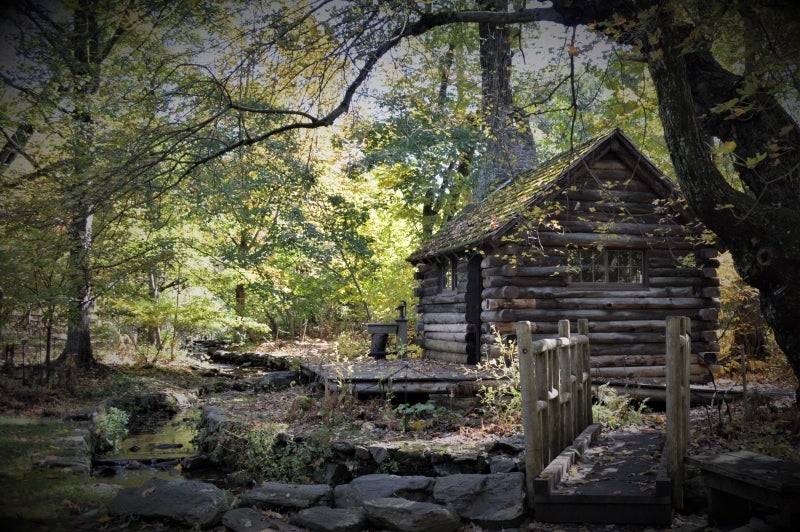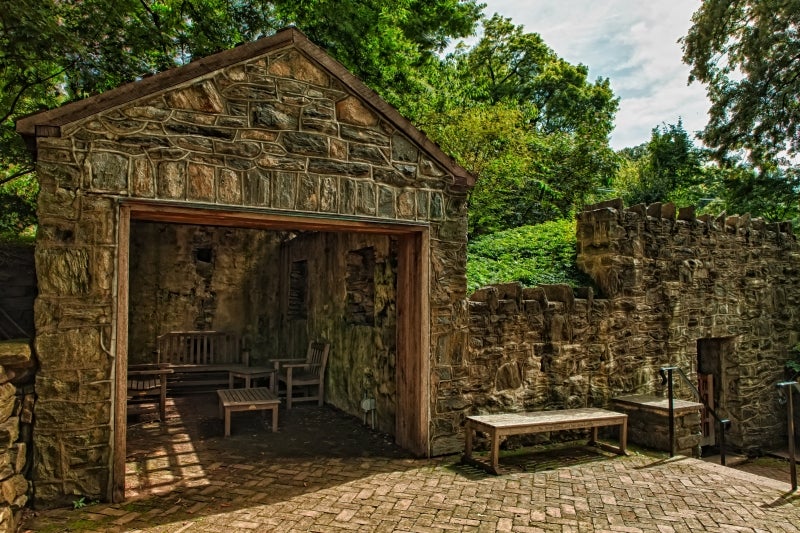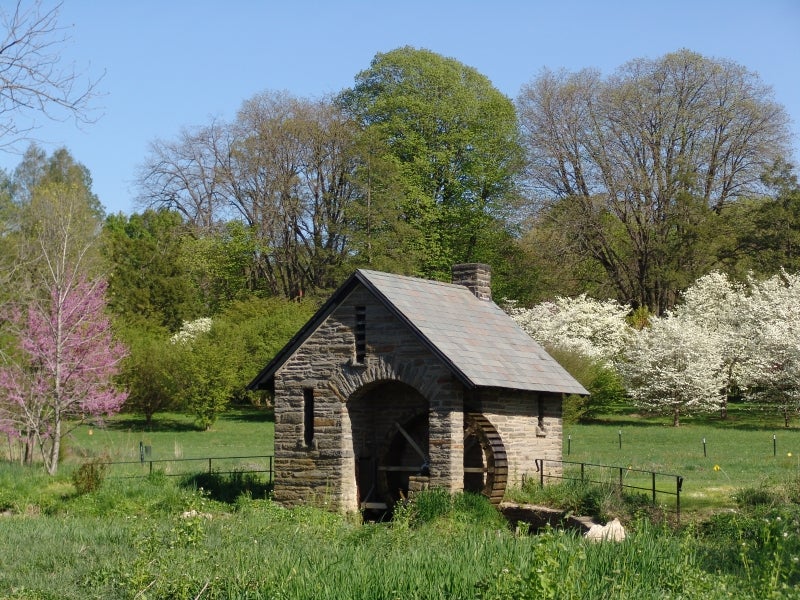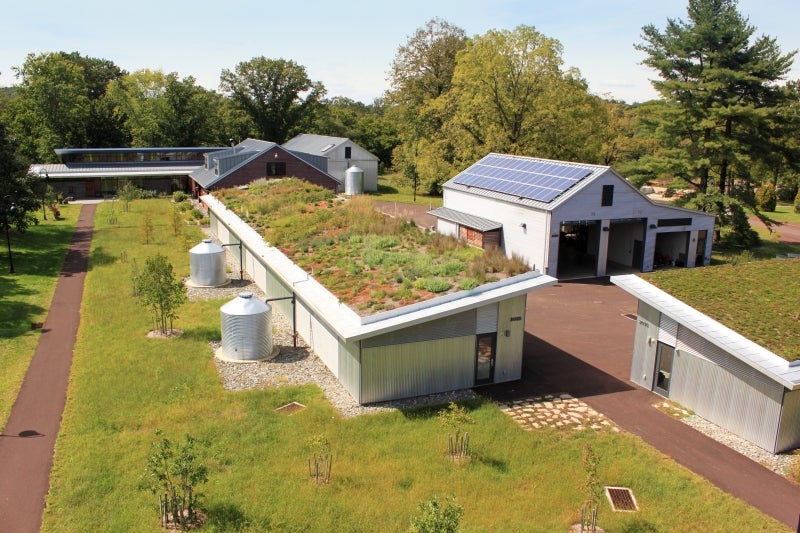Historic Structures
The Log Cabin

Visitors can step into the shoes of our founder, Lydia Morris, and take a trip back in time in the Log Cabin. From entertaining friends to enjoying quiet time on the porch watching woodlands along the stream, the Log Cabin was used as Lydia’s private retreat. John Morris designed and ordered the construction of the cabin in 1908. Similar in style to the nostalgic vacation cabins of the Adirondacks, complete with a river-stone cobble chimney. The building was cool in the summer, and a fireplace provided warmth for the cold winter. The Log Cabin was later restored in 1995 and remains an idyllic spot to enjoy spring bulbs and other short-lived native plants particularly.
The Springhouse

See one of the few remaining Springhouses in Philadelphia and all its hidden treasures! This springhouse pre-dates the Morris estate and can be traced back to when the property was first used as a dairy farm. In its home, alongside the spring-fed creek, the springhouse was used to store dairy products and other chilled perishables. However, the larger adjacent building remains a mystery. Its structural accents, like a chimney and fireplace, are speculated to have also been used for storage, dairy product preparations, or possibly even a smokehouse.
In 2004 this historical structure underwent a complex restoration. The stone walls were rebuilt, including a 38-foot wall with seating, granite steps, brick paving, new wooden beams to suggest a roof, and enhancements to the surrounding landscape.
The Springhouse complex offers a tranquil resting spot with an open view of the trees above. It lies close to the Azalea Meadow while also providing visitors with an opportunity to learn about an earlier era.
The Pump House

At the time of its construction in 1908, the Pump House was an integral feature of the estate. Its wheel powered a three-cylinder pump which pushed water uphill to a cistern in the tower of the former Compton mansion. It also provided water for grazing livestock, served to drain the meadow and was used to send water up the hill to the garden’s fountains. A 1917 City Water Map shows the Pump House was no longer in use, as all of the Morris's fountains were hooked up to the city water system by that time. The Pump House was renovated in 1994, and serves to greet visitors entering through the Northwestern Avenue entrance.
Springfield Mills
Springfield Mills and the Miller’s Cottage date back to 1761 and are the oldest architectural features at the Morris. Springfield Mills contains the most complete inventory of original flour mill works and related machinery of any mill in the area. The mill, with its Oliver Evans mill works, provides a unique view of 19th and early 20th century agriculture and milling in the Wissahickon Valley. Volunteers and staff are actively engaged in restoring the mill with the goal of renewing its water-powered operation. Springfield Mills is a contributing structure in the Morris’s National Register of Historic Places listing.
The connections between food consumption, food production and land use is hard to imagine in a society where supermarkets with have become our main link to food. The role of mills in communities is largely forgotten or taken for granted. Springfield Mills creates a visual narrative of the social, economic and technological role mills play in food production and how important land conservation and plant variety are to assuring we have food on the table.
Farmers came from many miles to have their grain ground into flour.The Flourtown Village was the great wheat market of the eastern counties of the state around and north of Philadelphia.
The mill used water power for an array of functions including sawing timber, grinding flour and animal feed, generating electricity, running agricultural machines and pumping water to irrigate the fields.
Learn how to bake the Springfield Mills cornbread muffins →
The historic grist mill dates back to 1761 and is situated along the picturesque Wissahickon Creek. On a guided interactive tour, watch one-ton millstones grind corn kernels, observe 160-year-old machinery transport and sift ground corn to produce meal, and even grind your own flour on a pedal-powered mill. Free with Morris admission.
Volunteer at the Mill
The Run-of-the-Mill volunteers work to preserve the use and operation of Springfield Mills. The mill stones and water-powered machinery are over a century old and require regular maintenance. Volunteers work on the mill throughout the year and operate the mill for visitors during Mill Demonstration Days at Bloomfield Farm. Volunteer activities include carpentry, masonry, equipment restoration, and general clean up.
Contact: Jenny Rajotte – jrajotte@upenn.edu or 215.247.5777 ext.236
Mills of the Wissahickon Valley
The historic Wissahickon Valley was home to over sixty mills from colonial times to WWII. Springfield Mills is one of four remaining Mills of the Wissahickon you can tour or visit. Explore all the mills of the Wissahickon.
Links to other local mills
Society for the Preservation of Old Mills (SPOOM) MidAtlantic Chapter
Questers Support Restoration of Springfield Mills
On May 5th, 2014 the Questers Fairwold Chapter with Pennsylvania State and International Questers presented a $7,000 grant to the Morris Arboretum & Gardens of the University of Pennsylvania for continued restoration of Springfield Mills. The Fairwold Questers have supported restoration of the Morris’s grist mill since 2008. Previous grants restored the mill windows and the turbine pit bridge. Both were critical elements in re-opening the mill for tours. Most recently the historic, two-ton mill stones grinding surfaces were refinished by an expert millwright and are grinding corn meal after 60 years of inactivity. This new grant will help restore the wooden “blow-out” wall facing the Wissahickon Creek. The grant was presented by Vickie Sierchio, Fairwold Quester President.
Questers is an international organization with 101 chapters in PA and chapters in 41 states and Ontario. Questers supports conservation and restoration of historical sites and objects. For information, go to www.PAQuesters.com and www.questers1944.org.
Horticulture Center

LEED® Platinum Certified Horticulture Center
Conserving natural resources to build a sustainable future.
This 20,840-square foot facility provides work space for the Morris’s horticulture, public programs, and facility staff. The new space provides the infrastructure needed to match the tremendous growth the Morris has experienced over the past 30 years and to address future expansion of the institution. The “green” elements of the Horticulture Center serve an even greater function, through providing unique opportunities to educate the public about the importance of protecting our natural resources.
The Horticulture Center is not open to the general public to visit without a class, tour, or event scheduled in advance. The general public is welcome and encouraged to schedule a prearranged visit to see the eco-friendly structure.